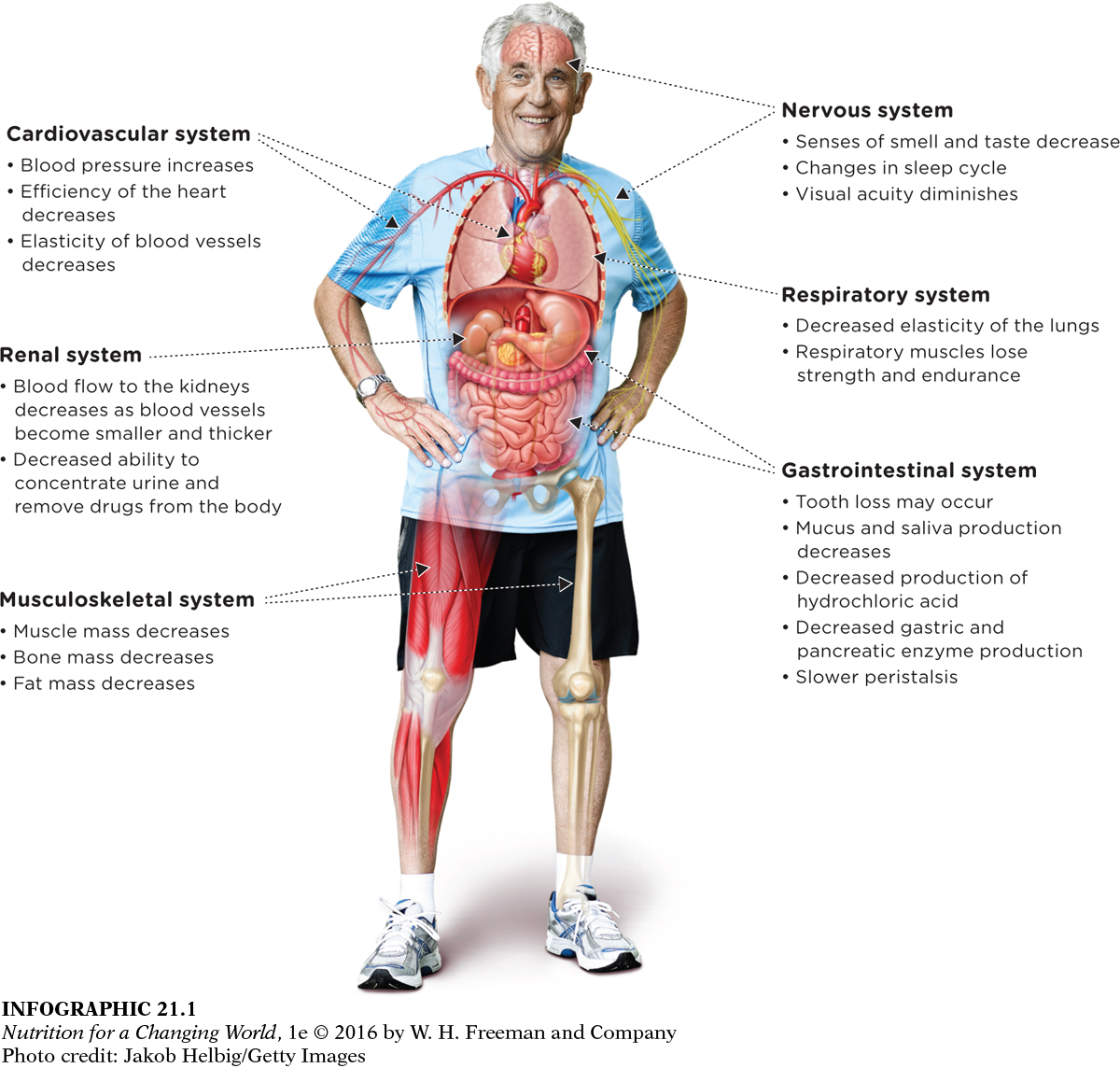WHAT HAPPENS WHEN WE AGE?
AGING the accumulation of diverse, harmful changes in cells and tissues with advancing age that is responsible for the increased risk of disease and death
The time we spend as children and young adults is characterized by the acquisition of new skills, physical growth and maturity, and psychological development. Although we continue to learn and enjoy new challenges throughout our lives, eventually, as we advance in years, the human body experiences some signs of deterioration or decline that we recognize as aging. Aging is the accumulation of diverse harmful changes that occur in cells and tissues that are responsible for decreased physical and mental capacity and an increased risk of disease and death. Aging is a complex multifaceted process that varies from person to person; however, over time it affects the cells and all of the major organ systems of the body. (INFOGRAPHIC 21.1)

Question 21.1
 How might age-related changes in the body influence the development of nutrition-related health problems? Give at least one example.
How might age-related changes in the body influence the development of nutrition-related health problems? Give at least one example.
Many answers are possible, but importantly, age-related gastrointestinal changes can affect nutrient absorption, making nutrient deficiencies more common. The digestive system can also reduce the production of stomach acid, which increases the aging adult’s risk of foodborne illness.
The changes in the body associated with aging are due to changes in individual cells and the organs they make up. As cells age, cellular functioning slows. Also, in some organs, cells die and are not replaced, so the number of cells decreases. The number of cells in the liver and kidneys for example, decreases as the body ages. However, even with this decline in cell number, most functions remain adequate because organs begin with more capacity than the body needs. For example, if half the liver is destroyed, the remaining tissue is more than enough to maintain normal function. Thus, disease and illness, rather than normal aging, usually account for most of the loss of function in old age.
Over the years a number of theories have been proposed to explain the process of aging. These theories are generally divided into two broad categories: programmed theories that contend that aging follows a biological timetable, and damage or error theories that suggest that aging is caused by an accumulation of molecular and cellular damage.
Major programmed theories of aging include: (1) programmed longevity—the switching on and off of specific genes that leads to aging; (2) the endocrine theory—where age-related alterations in the regulation of the endocrine system (including stress hormones and insulin) control the rate of aging; and (3) the immunological theory—which suggests that the immune system is programmed to decline over time which causes increased vulnerability to disease.
Some of the leading damage or error theories of aging are: (1) free radicals cause oxidative damage to proteins, lipids, and DNA; (2) protein cross-linking impairs protein function; (3) DNA damage results in mutations that cause cells to malfunction; and (4) epigenetic changes to DNA alters patterns of gene expression (see Chapter 1). It should be appreciated that aging is a complex process that involves a number of these mechanisms, and many of these mechanisms are interconnected.
One body system that is significantly changed in the aging adult is the cardiovascular system (the heart and blood vessels). Blood flow to the body declines due to many factors, including atrophy of the heart muscle, calcification of the heart valves, loss of elasticity in the artery walls, and fatty deposits in the arteries. The reduced blood flow causes older adults to tire more easily than younger adults since less oxygen is being exchanged, which in turn, reduces kidney and liver function, and provides less nourishment to the cells. This means older people are more likely to experience side effects from drugs, have a slower rate of healing, and an impaired response to stress. Even though organ functions often remain adequate in aging, the decline in optimal function means that older people are less able to handle strenuous physical activity, extreme temperature changes in the environment, and illness.